Everyone loves the big bullet. But one of the reasons why the models in this test are in production probably has more to do with a recent announcement by the United States military. A proposal was made to move away from the Beretta M9 and substitute a 45 ACP pistol with thumb safety and higher capacity than the traditional 1911 Government model. Plans to adopt such a pistol prompted several manufacturers to produce prototypes. Subsequently, the military decided to stand pat with the Beretta.
Nevertheless, participating gun makers thought they might as well let the public decide if these new designs were worthwhile. Thus, all three pistols in this test, the $623 Taurus OSS No. 24/7-OSSDS45B, Springfield Armorys $571 XD45 No. XD9661HCSP, and the $743 Smith & Wesson M&P No. 109107, can be made safe by lifting a thumb-operated safety.
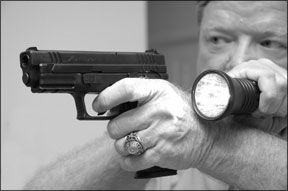
Some of the questions we wanted to answer had to do with carry options and ergonomics. To withstand 45 ACP recoil, these guns were bigger and built heavier than the 9mm and 40 S&W models generally associated with polymer design. Would adding a full load of heavy ammunition make the guns too much to carry? What about reliability? Would the magazine springs remain strong enough to lift the final rounds into position? To test this last proposition, one magazine of each gun was left fully loaded with the 230-grain Black Hills JHP +P rounds for 14 days.
What about the thumb safeties? Did they interfere with maintaining a natural grip? Would they slow the shooter down in an emergency? Did the thumb safety cause malfunctions? Did we think the addition of the thumb safety made the gun safer to handle both tactically and administratively?
For this test, we fired indoors at Houstons Top Gun Handgun Training Center (topgunrange.com). There we tested from a distance of 15 yards from a sandbag rest. We also garnered comment from members of the public thanks to testing alongside one of the many corporate functions hosted by Top Gun staff. Test ammunition included three prime examples of 45 ACP ammunition. For a light-recoiling target round we chose Winchester USAs 185-grain FMJ loads. Next, we tried Federal Premium 230-grain Hydra-Shok JHP rounds, and for maximum power 230-grain JHP +P rounds from Black Hills Ammunition.
Heres what we learned:
Springfield Armory XD45 Service Model
No. XD9661HCSP 45 ACP, $571
The XD45 with thumb safety is the newest addition to the XD lineup. But the basic pistol has been around for quite some time. Before Springfield Armory had its name on it, the 9mm base model was being imported as the HS2000. This is significant. While others were just developing a polymer pistol, the HS was already
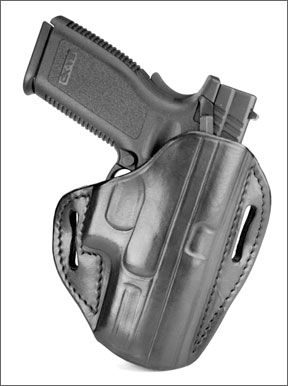
popular with police in its native Croatia. The original HS was evaluated in the April 2001 issue of Gun Tests, where we lauded its favorable ergonomics.
The XD had a safety lever located on the face of the trigger much like a Glock, but it also had a safety lever underneath the web of the hand that functioned as a grip safety. Other safety features consisted of a loaded-chamber indicator and striker ready indicator at the rear of the slide.
The XD pistol had a magazine-release button available from either side. The breakdown latch and the slide release were located on the left side of the pistol. Like on a Sig Sauer, removing the top end required locking back the slide and turning the latch. But in this case the lever was turned upward, passing through a cut in the slide. Once the latch was up and the slide released, the trigger must be pressed to free the slide. The top end, which offered a three-dot sight system dovetailed into place housed a linkless barrel that locked and unlocked over a steel block with slide rails on each side. Rails to the rear were polymer and fashioned as one piece with the grip frame. These rails helped align the slide. The rails in the center carried most of the stress.
An accessory rail with two slots was forward of the trigger guard. Two 13-round magazines were supplied. They featured viewing holes for each round and were constructed of shiny stainless steel. The basepads on all three pistols were removable, so springs and followers can be replaced when worn out. But the XD magazines were the simplest to disassemble. The magazine well featured a beveled profile to help insert the magazines. The XD package included a polymer belt slide holster (tension adjustable), and a dual magazine pouch with side rails for stowing any accessory that can fit on to the Picatinny rail.
The thumb safeties were located to the rear of the pistol on both sides. The levers rotated from an axis point just above the grip safety. The levers consisted of a stem that was countersunk into the frame and a raised section for contact. Both the slide release
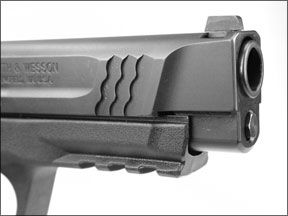
and the safety could be operated with the strong-hand thumb. The pad of the thumb naturally finds the slide release, and the knuckle can work the safety without a change in grip or shifting the pistol in the hand. The XD had an indentation on each side of the grip at the top of the panel. The indent was enhanced with a shelf along its bottom. We found this was the natural point on which to seat the thumb when shooting with one hand. Holding the gun in both hands, we achieved greater control by raising the thumb and letting the lower palm of the weak hand contact the grip panel. This also placed the strong-hand thumb close to the safety so we could operate it quickly at any time. This grip was judged more effective than using the support hand to cover the strong hand thumb. Covering the thumb left a hollow space between our palm and the grip. This allowed the gun to move around during recoil, causing us to re-grip the gun between shots.
Riding the safety (keeping the thumb atop the lever while firing) is a popular technique not only for keeping the safety lever under control but opposing recoil. The lever on the XD was almost, but not quite big enough, to act as a shelf on which to apply downward pressure. Without a platform perpendicular to the frame, undue pressure applied by the strong hand thumb can push shots to the side. Instead, we enjoyed applying light pressure to the safety with the edge of our thumb to control and locate our grip. No malfunctions of any kind were experienced with the XD, and the availability of the safety as an on/off switch assured safe handling.
Drawing from a holster, we were able to quickly turn the safety off between the time our muzzle was facing the target and our sight picture made us ready to fire. In our opinion, no time was lost. The
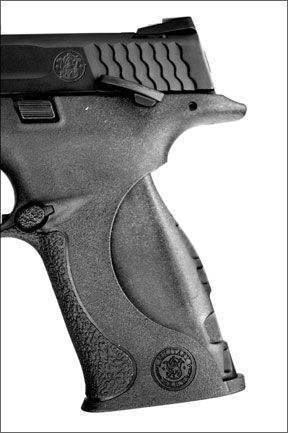
trigger did not require a long take-up, and there was plenty of feedback to the shooter. The XD system is thought of as being very close to a single-action design. The distance the trigger pushes back the striker is minimal compared to the Glock system. But the final movement was distinct. We always knew where we were in our press. Combined with the thumb safety, we felt we had complete control of the weapon.
In our hands the Springfield Armory XD was the most accurate despite having the shortest barrel, 4 inches, and the shortest sight radius. An average measurement of all five shot groups fired with all three test rounds worked out to less than 1.9 inches across. This included the smallest groups measuring from 1.4 inches to 1.7 inches center to center for each different round. All groups hit at point of aim.
We could attribute this success to the predictable trigger, the clear sights, and the quality of its lockup, but the grip had a lot to do with it, too. Not only does 45 ACP produce a lot of muzzle flip, but the big bullet has a tendency to torque the gun as well. The efficient grip helped us hold on to the gun and follow through on each shot. Simply put, we think the Springfield Armory XD with thumb safety is easy to shoot.
Smith & Wesson M&P45 No. 109107 45 ACP, $743
Of our three guns we felt that the M&P45 was closer to the 1911 than either the Taurus or Springfield Armory products. No, it did not have a grip-operated safety, but the profile of its slide looked like it could be used on a single-stack 1911. Some very effective cocking serrations on the front and rear of the slide continued the resemblance. The top of the slide was flat, and both sights were dovetailed into place. The rear sight was a low-mount unit with its rear face even with the back of the slide for maximum sight radius.
Overall, the M&P45 had a very sleek look. The length of the extractor was visible from the right side, but it was seated flush. The rake of the grip angle, topped with a beavertail that reached
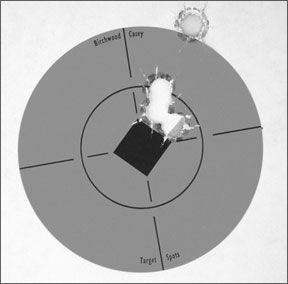
almost a full inch over the web of the shooters hand, set this gun apart from other polymer pistols. The dustcover offered a three-slot accessory rail. The magazine release was left side only, but in traditional location at the bottom rear of the trigger guard. The M&P45 featured ambidextrous slide releases and thumb safeties. The trigger itself was nearly a half circle in arc and was hinged to facilitate a safety device comparable to the Glock and XD models.
The grip of the M&P pistol offered a very pleasant, neutral texture. The back of the grip was removable. This also included a thin layer including about half of the side panel. To change inserts, required removing a pin that served two purposes. The top of the pin was located at the bottom rear of the grip as a continuation of its contour. You can also recognize the pin by the inlet that also served as a lanyard point. Turning the pin 90 degrees allowed it to be pulled out. This also released the rear panel. Three different-size panels were supposed to come with the gun, but for some reason we received one medium and two small sized panels. We doubt we would have used the large panel anyway, because we all preferred the panel marked small on the inside. Even so, we felt the backstrap was bulbous and unnecessarily noticeable. Wed rather not be conscious of the grip at all.
Checking with as many owners of the M&P pistols as we could find, we obtained some interesting feedback regarding the grip. Of the shooters who use the M&P in Practical Shooting competition, a number of them are not even using the inserts. They simply remove the insert and fill in the remaining void to suit their hands. This is feasible because no working parts are exposed with the backstrap removed. We tried shooting the M&P45 without an insert in place and could see the potential for improving the grip.
In addition to locking the grip insert into place, the pin also assisted in removing the top end. With the slide locked back, the pin was used to reach down past the breech face and push down on the sear deactivation lever. Next, the takedown lever could be rotated downward. Pressing the release should allow the slide to move forward off of the frame. However, we found that as the slide moved forward the takedown lever would sometimes leave its vertical position and rotate slightly. This would raise the rearward edge of the lever so that it would catch on the relief in the slide meant for the slide catch as it slid past, causing the slide to jam. We were careful to keep the takedown latch vertical to prevent this from happening during reassembly as well as takedown. With the top end removed, we found a complex action including springs and transfer bars.
At the firing line we learned several characteristics of the M&P45. First, you could ride the safety. This meant the strong-hand thumb could be placed atop the paddle to assist in recoil control. This design also guaranteed a sure grip when pushing it up or down (on or off).
Next, we began with the lighter recoiling Winchester USA 185-grain FMJ rounds. The M&P printed groups that averaged less than 2.0 inches across. This was our best effort with the Smith & Wesson.
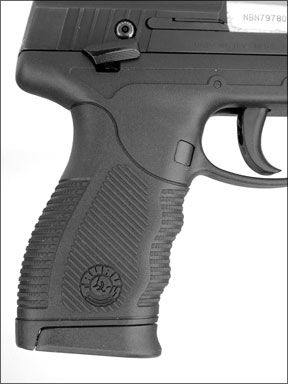
But we might judge that the M&P45 was not tuned for these rounds as the cases consistently flew straight back from the ejection port into our shooters forehead. Our more powerful rounds printed five-shot groups that averaged about 2.5 inches across at 15 yards. But the gun ejected spent cases cleanly and quickly away from the shooter. We dont think the difference in accuracy could be attributed to the ammunition per se. The M&P recoiled with sizeable muzzle flip that tested our follow through.
One additional problem we encountered was when we loaded the gun with the slide already locked back, the slide would pick up a round and move into battery on its own just as the magazine was seated. This may sound convenient, but we prefer to be in control of the gun.
The overall profile of the M&P45 makes it most appealing. Holding the gun and sighting down a target tempted us to whisper to ourselves with enthusiasm. But we think a few smaller points of finish need attention. Regarding the variety of alternate backstraps, were not sure the M&P really needs that much help. Much of the gun already mimics the better features of the Browning 1911. Perhaps continuing this theme to the rear of the grip may be the better choice.
Taurus OSS No. 24/7-OSSDS45B 45 ACP, $623
Of our three guns the Taurus OSS had the longest barrel, 5.25 inches, and a sight radius that we might refer to as luxurious. This gun is the big brother to the 24/7 series pistols that are also full-time double-action only with ambidextrous thumb safeties. Magazine capacity for the 9mm tops out at 17 rounds and the 40 S&W model will carry 15+1 rounds. Our forty-five was a 12+1 round model but all the 24/7s ship with 10-round magazines where required by law.
Of our three manufacturers, Taurus has been offering a thumb safety the longest, not to mention chambering polymer pistols for 45 ACP. We have found the ergonomics of the 24/7 series pistols to be outstanding. The OSS was no exception. Unique to the OSS was the amount of weight biased towards the muzzle. This helped tame muzzle flip.
Overall, the OSS offered the impression that serious business was about to take place. This same basic platform is available in a variety of color schemes and in calibers 9mm and 40 S&W as well as 45 ACP. The black slide on our pistol was topped with a Novak sight dovetailed and set with an Allen screw. The front sight not only offered a white dot but also a generous tall outline for the shooter to see. It, too, was dovetailed and fixed with an Allen screw. The slide had cocking serrations front and rear that were visually understated but effective. The externally mounted extractor was topped with a segment that was designed to bulge outward when the chamber was loaded for tactile indication. There was a key-operated lock on the right side of the slide. Up front was an accessory rail with two cross hatches. The slide release and the slide stop pin were located on the left side of the frame. Thumb-operated safeties were on both sides. The grip undercut the slide and swept downward gracefully, providing a comfortable palm swell. The front strap offered mild finger grooves. Along the side of the frame on both sides were mild indentations just above the front of the trigger guard. According to the taurususa.com website, the OSS pistol was “built to meet and/or exceed all requirements laid down by USSOCOM, (United States Special Operations Command) for its new sidearm” and that it included “features that real-world professionals were asking for.” Were not sure these indents were among the requests, but we liked them as finger-off- the-trigger points of reference anyway. We can see how they would be helpful especially while wearing gloves.
Disassembly required locking back the slide, rotating the slide stop downward and pulling it from the frame. Releasing the slide and pressing the trigger allowed the slide to move forward off of the frame. The Taurus 24/7 pistols actually come in three parts. They were the top end consisting of slide, barrel and recoil assembly; an aluminum assembly that housed the action and provided the frame rails; and the plastic grip frame. The only trick to reassembly was to tilt the gun muzzle down with the slide locked back so that the barrel was fully forward. This way the slide stop will be properly positioned. Replacing the slide stop pin required turning it as you pressed inward above the retaining leaf spring.
The thumb safeties were easy to operate, available primarily to the inside of the thumb at the knuckle. The safeties were not in the shape of a paddle, but some members of our staff were able to ride the safety and some werent. Top to bottom the grip was not very tall. This helped make the gun more concealable, but we had to move our support hand out of the way for the strong-hand thumb to get underneath the safety and push it to the On position. The trigger stroke was long and ignition occurred when the trigger was nearly up against the frame. Shooters with longer fingers or larger hands found this awkward.
At the range we fired the 185-grain FMJ rounds first. Groups ranged in size from 2.0 to 3.7 inches across. Since recoil from the light loads in the big heavy gun was minimal, we judged that follow through was not a problem. The difference in size between our smallest groups and are largest grew as we increased the power of our ammunition. The Federal Hydra-Shok was more consistent but not sterling. Groups varied in size from 3.0 to 3.6 inches across at a distance we would consider minimal for a gun with very good sights and a 5.25-inch barrel. Firing the 230-grain JHP +P ammunition, groups jumped to more than 5 inches wide.
But that is not the whole story.The first shot in each group of this powerful ammunition was flying high to the left. The remaining four shots were producing groups about 1.5 inches across. In our opinion, the lockup produced by hand-cycling during the loading procedure did not produce the same quality of mechanical lockup achieved by the velocity and force produced by ignition. Maladies such as this used to be common among semi-automatic pistols. The design concept of the Taurus OSS pistol should have, in our opinion, produced consistency if not the best accuracy. This design offered the most slide-to-frame contact which, when hand fit, can be beneficial.
Unfortunately, we also suffered malfunctions. One such malfunction caused the slide to lock back with rounds remaining inside the magazine. But the majority involved the inability to chamber the final round. This problem was more prevalent with hollowpoints.
0708-Springfield-Armory-XD45-Service-Model.pdf





























